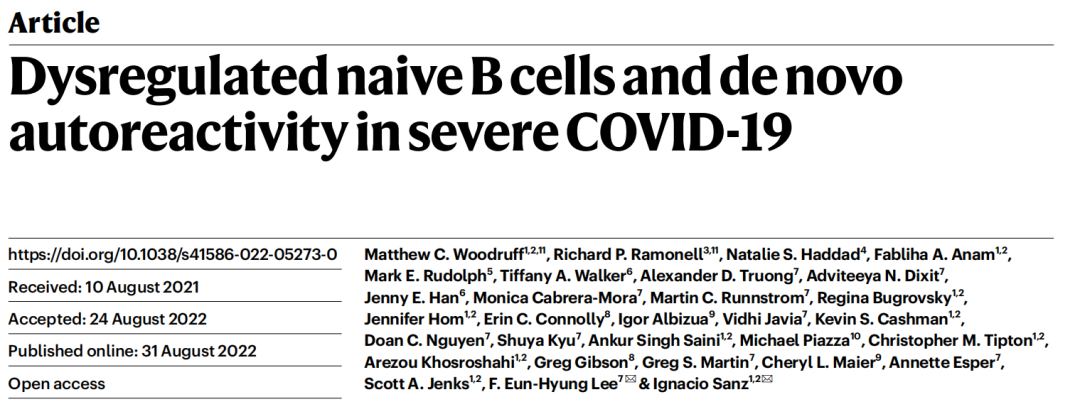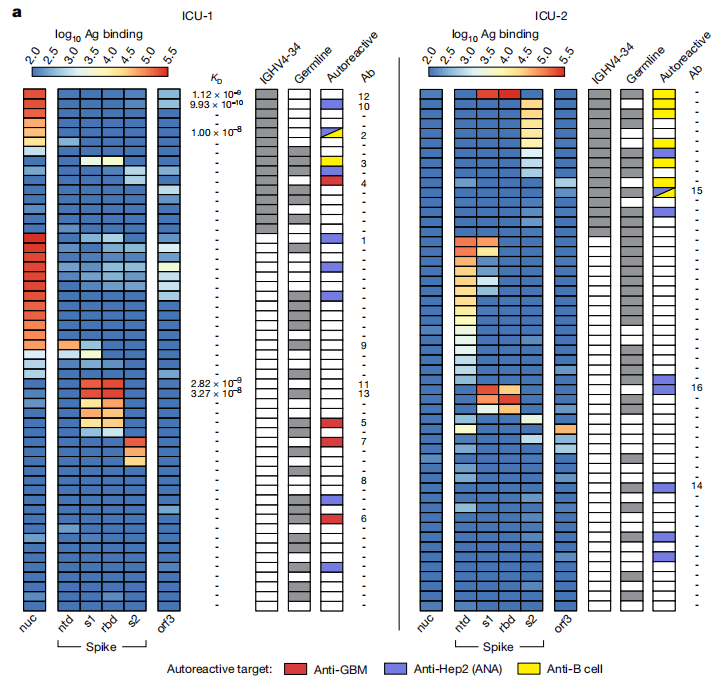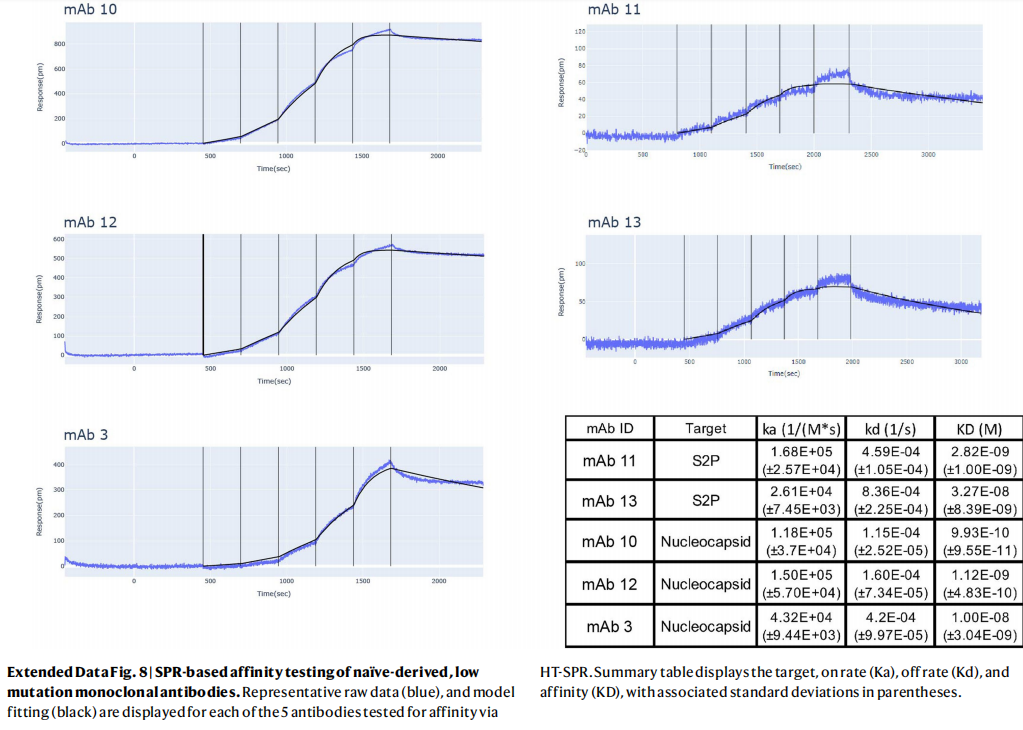
在本文中,作者使用Nicoya Alto这款高通量的SPR仪,采用16通道进行单克隆抗体与病毒蛋白作用的动力学分析及亲和力测定。
采用 1:1 动力学相互作用模型拟合mAbs与SARS-Covid-2的核衣壳蛋白(Nucleocapsid)及突刺蛋白三聚体(S2P)相互作用的动力学。
Alto™为16通道,为蛋白互作分析提供了一个高通量、省时、省力、省样的台式解决方案。
仅用2μL分析物就可以获得完整的结合动力学数据。
- 摘要
- Summary
自Covid-19大流行以来,严重的SARS感染一直与高度炎性免疫激活有关。最近发现,这些反应与具有潜在致病的自我反应性抗体的出现有关,尽管它们的起源和解决办法仍不清楚。之前,我们和其他研究人员已现了滤泡外B细胞的活化(一种在慢性自身免疫中与de novo自体反应性抗体形成相关的途径),是危症、重症COVID-19的主要特征。通过分析轻、重症患者单细胞B细胞库,我们发现抗体分泌细胞(ASCs)的naive-derived低突变IgG1群体显示出低选择压力的特征。在出现症状的10-15天,这些特征与累进的、广泛的、临床相关的自身反应性有关,特别是抗核抗原和氨甲酰化蛋白。对低选择室的详细分析揭示了高频率的 SARS-CoV-2 和自身抗原特异性克隆型,包括针对肾小球基底膜的致病性自身抗体。我们进一步确定了该途径在恢复、重新建立耐受标准以及伴随的急性衍生 ASC 损失而与抗原特异性无关的收缩。然而,血清学自身反应性在一部分急性后遗症患者中持续存在,这引发了关于新出现的自身反应性对恢复后持续症状的贡献的重要问题。总的来说,这项研究揭示了重症 COVID-19 自身反应性的起源、广度和解决方案,对 COVID-19 后遗症患者的早期干预和治疗具有重要意义。
Severe SARS-CoV-2 infection1 has been associated with highly infammatory immune activation since the earliest days of the COVID-19 pandemic2–5 ,More recently, these responses have been associated with the emergence of self-reactive antibodies with pathologic potential6–10, although their origins and resolution have remained unclear11. Previously, we and others have identifed extrafollicular B cell activation, a pathway associated with the formation of new autoreactive antibodies in chronic autoimmunity12,13, as a dominant feature of severe and critical COVID-19 (refs. 14–18). Here, using single-cell B cell repertoire analysis of patients with mild and severe disease, we identify the expansion of a naive-derived, low-mutation IgG1 population of antibody-secreting cells (ASCs) refecting features of low selective pressure. These features correlate with progressive, broad, clinically relevant autoreactivity, particularly directed against nuclear antigens and carbamylated proteins, emerging 10–15 days after the onset of symptoms. Detailed analysis of the low-selection compartment shows a high frequency of clonotypes specifc for both SARS-CoV-2 and autoantigens, including pathogenic autoantibodies against the glomerular basement membrane. We further identify the contraction of this pathway on recovery, re-establishment of tolerance standards and concomitant loss of acute-derived ASCs irrespective of antigen specifcity. However, serological autoreactivity persists in a subset of patients with postacute sequelae, raising important questions as to the contribution of emerging autoreactivity to continuing symptomology on recovery. In summary, this study demonstrates the origins, breadth and resolution of autoreactivity in severe COVID-19, with implications for early intervention and the treatment of patients with post-COVID sequelae.
- 概述
在对早期干预和covid后遗症患者治疗的解决方案中,本文作者利用Nicoya Alto高通量SPR仪,对筛选出来的抗SARS-COV-2的SP2/Nucleocapsid的mAbs表征了动力学及亲和力(只展示部分数据)。所有数据以1:1的参考方式在Nicoya Alto上实时收集。


- 材料和方法
仪器:Nicoya Alto
传感器:carboxyl-coated sensors
配体:S2P、Nucleocapsid
分析物:mAbs
分析模型:1:1
各抗原的配体结合和再生条件如下:
S2P-将SARS-CoV-2的S2P重悬于pH为4.5的Tris醋酸缓冲液中,并在EDC/NHS活化的羧基传感器上固定,50 μg/ml,5 min。
用甘氨酸HCl (pH 2.5)对传感器进行1分钟的再生。
Nucleocapsid-将SARS-CoV-2的Nucleocapsid重悬于pH 6的Tris醋酸缓冲液中,在EDC/NHS活化的羧基传感器上固定,50 μg/ml,5 min。
用甘氨酸HCl (pH 3)对传感器进行1分钟的再生。
稀释:3倍稀释5个浓度点,S2P、Nucleocapsid终浓度分别为222 nM和914 pM。
分析方式:单循环。
运行Buffer:磷酸盐缓冲盐水(0.05%吐温)。
温度:25℃。
- 结论
使用Nicoya Alto详细表征筛选后的mAbs与SARS-Covid-2的核衣壳蛋白(Nucleocapsid)及突刺蛋白三聚体(S2P)相互作用的动力学。Alto的16通道为样品检测提供了一个高通量的SPR检测,同时用量是传统SPR的百分之一,仅用2μL分析物就可以获得完整的结合动力学数据,使不可能变为可能。
作者评价


Matthew Woodruff
Assistant Professor, Dept. of Medicine
“经过一番研究, 我们最终选择了Nicoya,它能满足以下几个需求——成本低、易于维护、占地面积小、灵活以及极小的样品需求。我们为这个决定感到非常开心。
Nicoya团队使得仪器的安装和上机非常快捷和简单,为我们在实验室使用SPR技术提供了支持。在Alto来到实验室后的一个月,我们已经获得了用于发表publication的高质量数据…”
“After some searching, we identified the Nicoya Alto as the obvious choice to meet those needs due to its low cost and maintenance, small footprint, flexibility, and extremely small required sample volumes. We couldn’t be happier with the decision.
The Nicoya team made the equipment installation and onboarding quick and easy and has provided us the support we have needed to bring SPR into our lab’s investigative toolbox. Within a month of Alto’s arrival, we had developed publication-quality data for our upcoming manuscript…”
